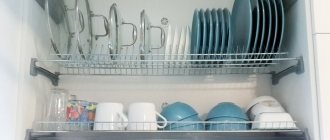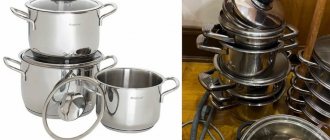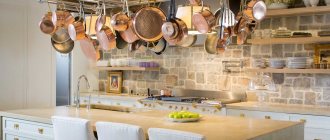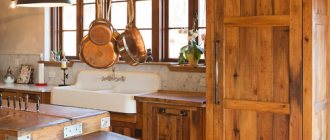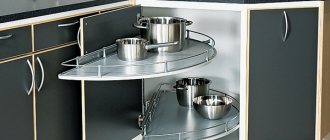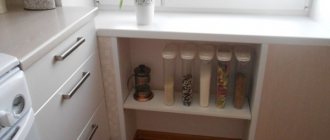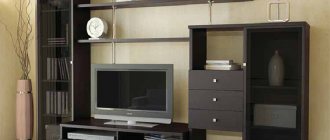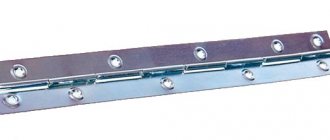Owners of small apartments often face a lack of space. This problem is especially acute in the kitchen. For example, how to store pot lids? After all, due to their non-standard shape, they take up too much free space. Below are the most successful solutions. The list includes both store-bought devices and those that you can make yourself.
Drainer
You can compactly store pot lids in the kitchen in a drying rack located inside a wall cabinet. Its advantage is that all the dishes are in one place and hidden from view, and the decor looks neater and more laconic. Usually a dish dryer comes with a kitchen unit. If there is not enough space in it, you can remove extra plates that are rarely used.
Table stand
An excellent accessory that is convenient to use while cooking. Condensation from the pan lid will flow onto the stand, and hot elements will not damage the countertop. You can also place a spoon or ladle on it. But this is rather an intermediate option - when the lid is removed from the pan, it needs to be put somewhere. For permanent storage in the kitchen, such a stand will not be convenient.
Rack for kitchen utensils
If there is free space on the countertop, it is convenient to store pot lids on a special stand with dividers. The stand combines the function of a dryer and can be made of metal, bamboo or plastic. It can be hidden in a wall cabinet or bedside table. There are many different types of storage racks. You can find a suitable option for both a small kitchen set and a large kitchen.
Materials
Lid stands for modern pots are made from materials whose texture and quality vary significantly. Models available:
- Made of wood - suitable only for dry, clean dishes. They look noble, expensive, and decorate the kitchen.
- Made of glass - they are rare, they fit perfectly into the interior of any style.
- Made of metal - suitable for both dry and wet dishes, practical, reliable in use. They require periodic cleaning and drying. Stainless steel retains its attractive appearance for a long time; rust may appear on structures made of other alloys when exposed to high humidity.
- Made of plastic - they decorate the interior with rich colors and fancy shapes. They do not last long due to rapid mechanical wear.
Models of any design require regular care. Stands, except for wooden organizers, should be periodically washed, deposits removed, wiped dry, and kept clean.
Wooden
Metal
Plastic
Wall holder
A common method for storing pot lids vertically in the kitchen is a metal frame structure with several crossbars. The holder can be mounted on the wall near the sink, stove, on the apron, or fixed on the door or side wall of the cabinet. The height of the device depends on the number of covers. The advantage of a hanging stand is that it saves space in cabinets. Disadvantages include dust settling and visual clutter in the kitchen. When placing the holder on cabinet doors, the shelves should be slightly narrower than standard so as not to interfere with the closing of the doors.
Drawer
One of the convenient ways to store pot lids in the kitchen is a separate drawer, which is often used as a tray for cutlery. When ordering a headset, you can provide several similar compartments.
Ovens are most often installed at some distance from the floor, so a basement drawer can be built under the hob to store kitchen lids.
Compartment in the cabinet drawer
If you are the owner of wide and deep kitchen cabinets, then the question of how to place the lids can be solved without difficulty. A spacious compartment should be provided inside the roll-out box, which will allow you to ergonomically organize its filling. Compartments can be built-in or purchased separately.
Door mounts
This method is only suitable for storing lightweight pot lids and durable doors. It saves space in the closet because it does not take up interior space. The device is fixed with adhesive tape. To secure, you can also use hooks, which are sold in construction and hardware stores. If the cabinet door does not allow this, use the front part of the kitchen facade for storage.
A more convenient form of holder for storing pot lids consists of two parts, since they can be installed at any distance. The device is made of durable plastic and is fixed to the wall with adhesive tape.
Fixation with hooks
How to Store Pots and Pans Lids Inside a Kitchen Cabinet
Closed storage is practiced by most housewives. Because in this way it is possible to maintain proper order, ensuring the concealment of objects thanks to the cabinet doors. In general, there are several options for storing cookware lids and accessories. The key advantage here is the concealment of objects. To ensure a decent place to store dishes, it is important to consider the size of the cabinet and the amount of money.
The closed type of storage is practiced by most housewives.
If you don't want to spend a lot on additional furniture parts, you can do some things yourself. In this case we are talking about holders that serve as organizing stands.
Railings
In addition to pot lids, you can hang everything for cooking on the rails - this way the worktop will not be occupied, and everything you need will be at hand. The surface underneath must be resistant to mechanical damage and easy to clean. Small rails can be attached to the inside of cabinet doors. Instead, rods are sometimes used to dry towels.
Pot lids that do not spoil the attractiveness of the kitchen - steel or glass - are stored openly. They blend into the surrounding environment, do not attract attention and do not clutter up the space. You can attach a hanging rack to the railing, which has special clamps.
Tools for storing pot lids
Door and wall rails. They are inexpensive and easy to make. Mounted on a wall or cabinet door. Before purchasing a roof rail, you need to measure the length of the surface that is selected for this purpose. There are no strict priorities for fastening and materials. In other words, the range of choices is wide and you can build on your personal preferences. The screwing process takes place using the supplied components or individually selected ones. After which you can safely hang the lids from the dishes and freely find them at the right time.
A common mistaken way to store lids is on the pans themselves. Of course, most housewives do this, but this is wrong, since it clutters up the free space in the kitchen. Owners make another mistake when they store the lids in a stack. Maybe this is appropriate for dishes, but for accessories with a protruding handle it is no good. Because this creates an unstable structure of dishes, which is about to fall apart and cause even more trouble for the housewife.
A common mistaken way to store lids is on the pans themselves.
If your kitchen boasts a large area, it makes sense to place dishes in a horizontal position. Although, of course, this is convenient, it requires a lot of free space. However, it is better to store the lids in doll-shaped drawers. It’s good if the pots are located on top, and the lids for them are located below, in special cabinets. You will save time searching for the right utensils and required accessories. Be sure to stack the lids in one column so as not to clutter the space in the cabinets.
Hooks on the wall
An alternative method is using hooks. They are usually placed above a hanging bedside table. These drawers can definitely be filled with some everyday items, but there is plenty of free space above them. Why not then use it for its intended purpose? A particularly win-win option is the lid handles in the form of loops. This makes it easier to hang them somewhere and provide your kitchen with additional free space. For solid pens, stores sell special holders. And yet, attaching them will not be as convenient as in the case of loops.
Hooks are usually placed above a hanging bedside table.
Holder
Towel holders are attached using a similar method - inside the walls and doors of the cabinet. The material of the product can be either wood or metal. If you have experience in fastening this type of structure, you will save significantly financially, and the product itself will be no worse than purchased.
Simpler designs are also suitable for holding kitchen utensils. To do this, take ordinary wire or a metal rod. We attach the thread with two self-tapping screws in the very place where the lids from kitchen utensils will be stored. Now all the necessary kitchen accessories are in plain sight, which will reduce the time spent searching for a particular lid.
To accommodate one lid, 2 to 4 hooks may be sufficient.
Lid holders can also be made using hooks. Attach the hooks with the back side (there should be special Velcro on this side) to the doors or inner wall of the cabinet. In accordance with the radius of the lid, secure the hooks to the desired width. In order to place one lid, 2 to 4 hooks are enough.
Providing your kitchen with more extensive storage can be done with homemade pegboard. You can purchase this kind of product at any hardware store. The main thing is to grab enough hooks. Secure them at an angle to ensure the lids are securely stored.
Stand
Stands made of metal or plastic. Suitable for cutting boards, large pots and pans. It is easy to purchase such stands, as well as to place them on the tabletop itself or inside the cabinet. An ordinary plastic drying rack can serve as a table stand. They are sold at any hardware store.
It is easy to purchase such stands, as well as to place them on the tabletop itself or inside the cabinet.
Hanger
Wall stand. In hardware stores you can see structures that are easily attached to the wall. Their key advantage is their low price, saving space, and the required equipment is at hand. A practical approach is to install the racks on the wall with a horizontal crossbar with hooks. Dishes and accessories will be stored in one place. A good option is also a perforated board. If previously it was in the garage, today it is openly used in kitchens. It costs nothing to attach a stand or hooks to it.
Their key advantage is their low price, saving space and the required utensils are at hand.
Delimiter
A box in a box. Well, to be specific, we are talking about a special compartment in a large cabinet. Naturally, such departments will be provided exclusively for lids and utensils. Visually, it will look like this: pots and pans are located in the center, and lids and other accessories are located on the sides. You can make such compartments yourself or order them in advance from craftsmen before making the kitchen set. Pay special attention to the width of such a compartment (at least 60 cm). Otherwise, the kitchen utensils simply won’t fit.
In the center there are pots and pans, and on the sides there are lids and other accessories.
Hinged structure for doors and walls. Such racks can also be made personally or ordered from professionals. The structure is attached to the inside of the wall or door. The choice of product depends on the size of the furniture and finances. They are divided into three categories: hooks, hangers and drawers. By the way, the latter are easily attached using a screw or special Velcro. The pull-out compartment is made of a mesh shelf that slides out along runners. Of course, this option is much more expensive than hooks and hangers. But it definitely looks nice. Guests will definitely appreciate this approach to storing dishes and lids.
The structure is attached to the inside of the wall or door.
When cooking, it is very convenient to use a special stand. This way you won’t waste time searching for the right kitchen item.
DIY string holder
A simple way to store pot lids in the kitchen to make with your own hands - you need to measure the diameter and fasten several strings or pieces of copper wire of a suitable length to two self-tapping screws inside the cabinet. They should sag a little so that the weight is distributed evenly along the entire length and ensures reliable fastening.
Instead of a string, you can stretch a rubber band that stretches and can support a pan lid of any size. When installing rails or strings, you need to take into account that the protruding handle does not interfere with closing the door. It should be located at the same level as the internal shelf.
